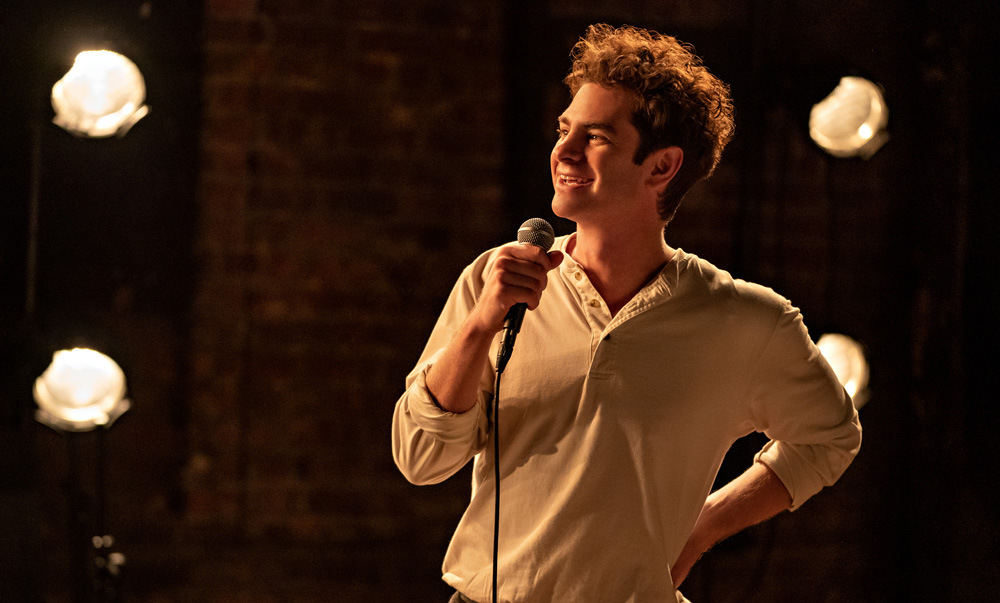We looked to those in the film community who went to great lengths to bring joy to audiences this year and a reason to be optimistic for the future in Our Favorites series. We will be highlighting their efforts throughout this week.
There was a palpable energy in the room the day that the cast and crew of “tick, tick…BOOM” were going to shoot “Boho Days,” a boisterous musical number set inside the apartment of Jonathan Larson (Andrew Garfield) surrounded by his friends, having surprisingly little to do with the propulsive verve that the future composer of “Rent” had already infused into the lyrics. The scene was one of the first filmed after a hiatus imposed by the pandemic and with the cast sequestered for 10 days to comply with health and safety protocols, the feeling was electric as the cast could gather in one space, an inevitably tight domicile befitting of an aspiring playwright who still was dishing out eggs at a local diner for a day job. Although it was a set designed for filming, the apartment had been replicated down to the last detail of what had been known about Larson’s place, somewhere cinematographer Alice Brooks had an intimate knowledge of when she grew up around artists in similarly cramped conditions in New York.
“That scene could’ve been out of my childhood,” said Brooks. “The warmth that only comes from little corners of the room— there’s this blue painting in the living room that actually belonged to Jonathan – that was where it was hung when he hung it on his apartment wall and every time I see it, it has this pop of color in this otherwise drab space and we lit the whole space with practical lights – we didn’t use movie lights at all. I wanted it to feel like you’re in that apartment. For so many people, no one had been able to be at a party for seven months, so the energy in that room just got into your soul.”
The pent-up excitement may have been tangible, but if anyone was going to know exactly how to pull it into the frame it was going to be Brooks, who not only just had the experience of lensing Lin Manuel Miranda’s other musical “In the Heights” with her longtime collaborator Jon M. Chu but could summon every bit of the magic she felt in her childhood to guide her camera around the city where the beauty often emerges from how difficult it can be to see at times amidst the hustle and bustle. As the film follows Larson chasing the dream of getting his first musical off the ground, with his self-doubt and anxieties as apt to get in the way when he’s less convinced of his talent than anyone else is, Miranda and Brooks envision Manhattan as the musical playground that their hero has in his head and fights mightily to get onto the page, with the playwright’s usual haunts of the Strand Bookstore and the Moondance Diner brought alive as he conjures lyrics and the world begins to dance around him.
Brooks is right there step for step with Larson, marshaling her camera crew to be as light on their feet as any of the performers in front of them and the massive equipment required makes their grace all the more impressive. Timing has been a strong suit for Brooks, who not only seems to have a sixth sense about responding to the emotion of any given scene and the way it manifests itself physically, but found herself at USC Film School at the same time as Chu, who was determined to make movie musicals after they had fallen out of fashion, first collaborating on his student short “When the Kids Are Away,”complete with a cast and crew of 175, and subsequently set to remake “Bye Bye Birdie,” though it wouldn’t come to pass. Instead, Chu would develop his skills as a director after taking over the “Step Up” franchise, which he leveraged to create “The Legion of Extraordinary Dancers,” a web series where he and Brooks could work out a visual language for dance that would take it in fresh cinematic directions as the show combined a number of different styles from ballet to krumping. That innovation has been brought to bear on the major musicals that the two have worked on since, taking the eye to places that would seem as impossible to reach as other contortions of the body they capture.
At the end of an especially triumphant year, Brooks spoke about how she made the movement on screen so dazzling, including having to sensitively maneuver around COVID and enabling herself to feed off what was unfolding before her.
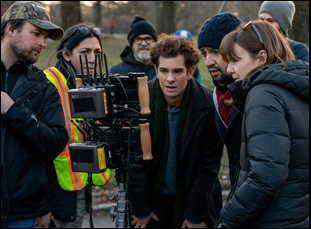
It did. I didn’t know when we were making “In the Heights” that Lin even had any aspirations to direct, but on the last day of filming “In the Heights,” I get a call from my agent saying, “Lin would like to send you the script and meet you on Tuesday, if you’re interested.” we wrapped “In the Heights” and over the weekend, I started reading the script and I turned page by page by page and I realized I felt very connected to the material. My father was a playwright and my mother was a dancer/singer and actress and we grew up, just like Jonathan, in a 300-square foot apartment with a bathroom in the kitchen in New York. Our hallway looked just like the hallway in “See No More” in “tick, tick, Boom” and our living room was filled with all my parents’ artist friends – “Boho Days” could’ve been a scene from any weekend at our apartment, just all that creative energy always being there and the struggle my father had trying to make it as a playwright and also us losing some of our friends to AIDS, so I felt this intense connection to the material immediately like “I can’t make this movie,” at first, “It’s too close to home.” Then I thought there’s no else who should make this movie and I hope Lin hires me.
Coming from the stage, I imagine talking with Lin about how to stage a musical must be different than Jon in terms of utilizing space and movement. Was that actually the case?
Yeah, Lin comes from 20 years of theater and there’s something very specific to theater that does not exist in film, but Lin brought it to our movie and it is workshopping a show. In theater, you workshop a show over and over and over again without a performance – it can be years. And there’s this spirit of collaboration where you’re discovering things with all your fellow other artists and you’re taking and sharing ideas and creating, so during prep, that’s the way he approached it. I saw the actors do this several times as a staged reading first and then we had them there the whole time to rehearse over and over and over again and then dance rehearsals and every day we would storyboard. It’s usually just me, the director and then the storyboard artist [generally on a film], but it wasn’t that at these sessions.
It was also the writer Steven Levenson, the production designer Alex DeGerlando and the assistant director Mariela Comitini, we all sat together at a table three to four hours every afternoon and go through specific scenes, mostly the musical numbers at first and start to draw things and the next day we’d come back and look at them and maybe they worked and maybe they didn’t, but then I would cut the scenes as animatics into pre-records and then we’d look at it again. So it was this constantly evolving discovery process for Lin where one of us would have an idea and he’d either love it or not, but then the writer was there and it was just amazing to be able to have ideas implemented on the page as we were discussing them. I’d never been in a prep where the writer was so readily available and it was one of the most creative collaborations I’ve ever had.

Oh my gosh, no. The way I approach any project is I prep, prep, prep, but there’s something magical that happens on set that you cannot be prepared for, so you can be 100 percent prepared for what’s on the page, but you can’t be prepared for what an actor brings, or the weather or a little thing in a location you didn’t notice before, but it’s usually the actors. The way I lit it and also the way we choreographed the camera was very much that I wanted Andrew to have the freedom to be able to do whatever he needed to do to really become Jonathan Larson, so even though there were things that were very, very meticulous, there are other things that we were able to let go of and let the moment take hold. I wasn’t attached to any perfect light or perfect camera move on this movie. The claustrophobia you feel in his apartment and in the Moondance Diner – these really tight, small locations and the imperfection of the light and even the lenses we were using, letting all of that raw creativeness be okay – [all made it so] you really earn then when Jonathan steps out and [for instance] pushes down the wall at the Moondance Diner for “Sunday.” You earn that breath of freedom of Jonathan’s dream.
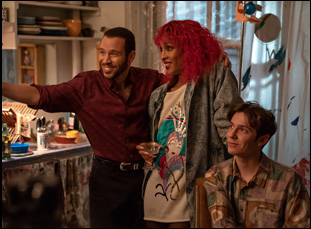
It’s a much darker film for sure than “In the Heights,” and it’s darker tonally as Jonathan’s going through the darkest moment in his life and figuring out whether or not his dreams are worth it, and it’s that moment where you could easily give up. Lin and I were both 10 years old in 1990 – and I actually moved from New York City to Los Angeles a few months before this movie begins, so the movie’s vision of New York is my forever New York, a 10-year-old’s vision of what New York was like in 1990 where color and light and emotions are all heightened. And Jonathan is such a childlike character – his first song “30/90” is about him wanting to be Peter Pan and never growing up and that childlike mind, sometimes the line between dreams and reality blur – that was the jumping off point where Lin and I [really talked about] what does this movie look like? So there is this constant push of light from the outside in, like you said, and then we get to the brightest scene in the movie where Jonathan basically gets to direct his own dream in the Moondance Diner. It’s like we enter this Seurat painting and the colors are all heightened and the brightness is all just a little bit more painterly versus his reality, so there is this darker, moodier heaviness [throughout], but the light is always there on the outside.
I’ve heard when it comes to lighting, at least in your work with Jon M. Chu, you would go through the scenes and try to narrow down things to a one word feeling to work from for the mood – was there a similar process here?
Yeah, with Jon, we definitely did that and in general, I’ve found because I grew up in the theater also and I was a child actor, I like having an intention for the camera for a scene, so I would ask Lin questions to get to what the intention really was and in this because we have only one main protagonist, it really was what is Jonathan’s intention? So I’ve got my whole script with little notes in the margin and any time I need to be reminded, it wasn’t necessarily one word, but it was an intention.
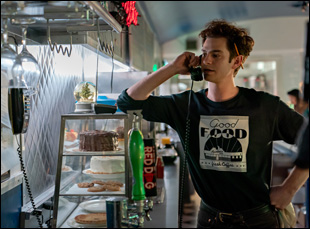
I got a very nice call the other day from someone who grew up in New York in this time period too and said that she couldn’t believe New York felt exactly like what her memory of it was. That’s the highest compliment because it was really important for us to honor Jonathan and the theater community. [For instance] the workshop feels like a workshop, it doesn’t feel like the movie version of the workshop and it was really important to Lin that nothing was faked. When you’re in these spaces, you really feel it would’ve been exactly like Jonathan would’ve experienced, so when we were in that Sondheim scene, we watched all these other writers’ seminars with Sondheim that are all on VHS because we wanted to get a taste of what that kind of experience was like in the ‘80s and ‘90s when things like this were taking place on a regular basis. You could go to these one-night things where people would break down your show and sometimes Sondheim would show up and it would be this really remarkable moment for a young writer.
Generally, was there much research you could draw on for references?
We had eight years of video on [Jonathan] and some of it you can see at the end credits, but his friend’s father was a documentarian and she filmed him all the time, so we really got to know Jonathan and not from some sort of public persona of him. Two weeks before Jonathan passed away, he was scared there was going to be a fire in his apartment, so for insurance purposes, he went around and recorded every single little detail of his apartment and so we had a journal of what was there, and in many ways, we live in a world where cameras are on us all the time, but in 1990, that was true for Jonathan. He had no clue that one day someone would be looking at these tapes, but we got him working at the Moondance Diner and him in his apartment and him with all his friends, they’d have these big dinners together in his apartment and we had it all on video. It gave us a really amazing record and it’s also how we introduce the movie is on this beta cam video for this opening and closing shot, but then we pepper in throughout, but it inspired us so greatly that we really wanted to feel that texture of the video to open and close the movie.
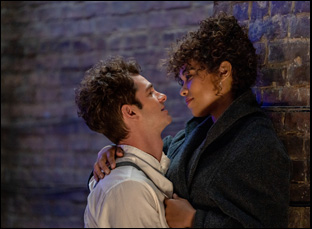
Yeah, a couple things came out of it. Suddenly, we weren’t allowed to use atmosphere for the movie because no one knew how COVID traveled through smoke particles in the air, so I took the lenses and I sent them back to Panavision in Hollywood and they stripped the coating further than I had them go before and I think it gives a life to the lens that we didn’t have originally. We also used an additional filter, so there was visual growth and a silver lining in that, but then what was also remarkable was the New York Theater Workshop, which was the first thing we scouted back in December 2019, knowing we never could shoot there because their theater is always booked for shows. They had a full season ahead of them, but we stood there and we fell in love with it and felt, “Gosh, this is the place where Jonathan performed ‘tick, tick, Boom’ and this is where it all began.” And we went to an old bottle factory in Bushwick we were going to build the theater in, but it was going to be a challenging space and not as big. When COVID hit, we ended up shooting at the New York Theater Workshop and we got to give back to the New York theater community, which was suffering so badly financially at the time too and we all stood on the stage and felt like Jonathan was right there with us. That was where he performed. It was a very sacred moment and in the middle of COVID, you couldn’t go see live theater, so Lin and I would sit in the audience and just be so grateful that we had seven days at the New York Theater Workshop where we got to experience as close to live theater as possible at the time.
And then you delivered that for the rest of us – I know the rest of the world is a year behind where you are as far as the experience, but what has this time been like with both “tick, tick, Boom” and “In the Heights” coming out?
I fell in love with musicals as a little girl. I watched Fred Astaire and Ginger Rogers movies all the time, we had them all on VHS and Rogers and Hammerstein and then every once in a while my parents would take me to a Broadway show and when I was in college, people weren’t making musicals and then Jon Chu approached me and said, “Hey, do you want to shoot my thesis film. It’s a musical short.” And I said, “Absolutely.” This was in 2002 before “Chicago” and “Moulin Rouge” and the renaissance of the movie musical. Now 20 years later, I’m getting to be part of this new renaissance of the movie musical and getting to work with Lin and Jon and all these Broadway greats, I could not imagine a more fantastic year. It’s just been a complete dream come true.




